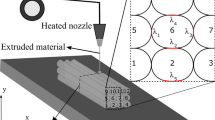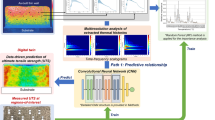Abstract
Digital Twins (DTs) are widely used for design, manufacturing, prognostics, and decision support for operations. One critical challenge in optimizing DTs usually involves multi-fidelity (MF) models and data, such as multi-resolution computational simulation and experimental testing. The MF strategies provide advantages of high accuracy with low computational and experimental cost in DTs. A novel MF optimization framework is proposed in this paper to demonstrate and validate its potential application in DTs. First, MF data aggregation using convolutional neural networks (MDACNN) is introduced to integrate low-fidelity (LF) and high-fidelity (HF) models and data. It can fully utilize the LF data to learn the relationship across multiple fidelities. With MDACNN, predictions can be made with high accuracy compared to HF models. Next, MDACNN is integrated into the neural optimization machine (NOM), an optimization framework based on NNs. NOM is explicitly designed for optimizing NN objective functions based on the stochastic gradient descent method. The integrated model is named MF neural optimization machine (MFNOM). A numerical example is presented to illustrate the procedure of implementing MFNOM. Two engineering applications are presented for both MF simulation models and experimental data. The first problem focuses on the multi-resolution finite element simulation for structures and materials. Coarse and fine meshes are applied for simulation. The properties of multi-phase heterogeneous materials are optimized to minimize the stress in the simulation domain. The second problem investigates the internal defects in additively manufacturing. Low/high resolution and full/partial field scanning data are utilized to build DTs. MFNOM is used to design pore size and orientation to reduce the risk caused by irregular pores.













Similar content being viewed by others
References
Arrieta A (2021) Multi-fidelity digital twins: a means for better cyber–physical systems testing? arXiv preprint arXiv:2101.05697
Barni A, Fontana A, Menato S, Sorlini M, Canetta L (2018) Exploiting the digital twin in the assessment and optimization of sustainability performances. In: 2018 International conference on intelligent systems (IS), 2018, pp 706–713
Bécue A, Maia E, Feeken L, Borchers P, Praça I (2020) A new concept of digital twin supporting optimization and resilience of factories of the future. Appl Sci 10:4482
Bouzid S, Viarouge P, Cros J (2020) Real-time digital twin of a wound rotor induction machine based on finite element method. Energies 13:5413
Cai Y, Starly B, Cohen P, Lee Y-S (2017) Sensor data and information fusion to construct digital-twins virtual machine tools for cyber–physical manufacturing. Procedia Manuf 10:1031–1042
Cao Y, Currie C, Onggo BS, Higgins M (2021) Simulation optimization for a digital twin using a multi-fidelity framework. In: 2021 Winter simulation conference (WSC), 2021. IEEE, pp 1–12
Chen J, Liu Y (2021) Fatigue property prediction of additively manufactured Ti–6Al–4V using probabilistic physics-guided learning. Addit Manuf 39:101876
Chen J, Liu Y (2022a) Fatigue modeling using neural networks: a comprehensive review. Fatigue Fract Eng Mater Struct 45:945–979
Chen J, Liu Y (2022b) Neural optimization machine: a neural network approach for optimization. arXiv preprint arXiv: 2208.03897
Chen J, Ersoy D, Liu Y (2020) Probabilistic bulk property estimation using multimodality surface non-destructive measurements for vintage pipes. Struct Saf 87:101995
Chen J, Gao Y, Liu Y (2022a) Convolutional neural networks for multi-fidelity data aggregation. In: AIAA SCITECH 2022a Forum, 2022a, p 2144
Chen J, Gao Y, Liu Y (2022b) Multi-fidelity data aggregation using convolutional neural networks. Comput Methods Appl Mech Eng 391:114490
Fayazfar H, Salarian M, Rogalsky A, Sarker D, Russo P, Paserin V, Toyserkani E (2018) A critical review of powder-based additive manufacturing of ferrous alloys: process parameters, microstructure and mechanical properties. Mater Des 144:98–128
Fernández-Godino MG, Park C, Kim N-H, Haftka RT (2016) Review of multi-fidelity models. arXiv preprint arXiv:1609.07196
Gao Y, Jiao Y, Liu Y (2021) Ultra-efficient reconstruction of 3D microstructure and distribution of properties of random heterogeneous materials containing multiple phases. Acta Mater 204:116526
Ghods S, Schur R, Schultz E, Pahuja R, Montelione A, Wisdom C, Arola D, Ramulu M (2021) Powder reuse and its contribution to porosity in additive manufacturing of Ti6Al4V. Materialia 15:100992
Grieves M (2014) Digital twin: manufacturing excellence through virtual factory replication. Google Scholar
Guerra RH, Quiza R, Villalonga A, Arenas J, Castaño F (2019) Digital twin-based optimization for ultraprecision motion systems with backlash and friction. IEEE Access 7:93462–93472
Guo H, Chen M, Mohamed K, Qu T, Wang S, Li J (2021) A digital twin-based flexible cellular manufacturing for optimization of air conditioner line. J Manuf Syst 58:65–78
Harrigan TP, Mann RW (1984) Characterization of microstructural anisotropy in orthotropic materials using a second rank tensor. J Mater Sci 19:761–767
Jones D, Snider C, Nassehi A, Yon J, Hicks B (2020) Characterising the Digital Twin: a systematic literature review. CIRP J Manuf Sci Technol 29:36–52
Karanjkar N, Joglekar A, Mohanty S, Prabhu V, Raghunath D, Sundaresan R (2018) Digital twin for energy optimization in an SMT-PCB assembly line. In: 2018 IEEE international conference on Internet of Things and intelligence system (IOTAIS), 2018. IEEE, pp 85–89
Kasperovich G, Haubrich J, Gussone J, Requena G (2016) Correlation between porosity and processing parameters in TiAl6V4 produced by selective laser melting. Mater Des 105:160–170
Lai X, He X, Wang S, Wang X, Sun W, Song X (2022) Building a lightweight digital twin of a crane boom for structural safety monitoring based on a multi-fidelity surrogate model. J Mech Des 144(6):1–8
Lim KYH, Zheng P, Chen C-H, Huang L (2020) A digital twin-enhanced system for engineering product family design and optimization. J Manuf Syst 57:82–93
Liu S, Shin YC (2019) Additive manufacturing of Ti6Al4V alloy: a review. Mater Des 164:107552
Liu Q, Leng J, Yan D, Zhang D, Wei L, Yu A, Zhao R, Zhang H, Chen X (2021) Digital twin-based designing of the configuration, motion, control, and optimization model of a flow-type smart manufacturing system. J Manuf Syst 58:52–64
Liu L, Song X, Zhang C, Tao D (2022) GAN-MDF: an enabling method for multi-fidelity data fusion. IEEE Internet Things J 9(15):13405–13415
Meng X, Karniadakis GE (2020) A composite neural network that learns from multi-fidelity data: application to function approximation and inverse PDE problems. J Comput Phys 401:109020
Min Q, Lu Y, Liu Z, Su C, Wang B (2019) Machine learning based digital twin framework for production optimization in petrochemical industry. Int J Inf Manag 49:502–519
Motamed M (2020) A multi-fidelity neural network surrogate sampling method for uncertainty quantification. Int J Uncertain Quantif 10(4):315–332
Mourtzis D, Angelopoulos J, Panopoulos N (2021) Equipment design optimization based on digital twin under the framework of zero-defect manufacturing. Procedia Comput Sci 180:525–533
Peherstorfer B, Willcox K, Gunzburger M (2018) Survey of multifidelity methods in uncertainty propagation, inference, and optimization. SIAM Rev 60:550–591
Sanaei N, Fatemi A (2021) Defects in additive manufactured metals and their effect on fatigue performance: a state-of-the-art review. Prog Mater Sci 117:100724
Schleich B, Anwer N, Mathieu L, Wartzack S (2017) Shaping the digital twin for design and production engineering. CIRP Ann 66:141–144
Seshadri BR, Krishnamurthy T (2017) Structural health management of damaged aircraft structures using digital twin concept. In: 25th AIAA/AHS adaptive structures conference, 2017, p 1675
Sharma A, Chen J, Diewald E, Imanian A, Beuth J, Liu Y (2022) Data-driven sensitivity analysis for static mechanical properties of additively manufactured Ti–6Al–4V. ASCE–ASME J Risk Uncertain Eng Syst B. https://doi.org/10.1115/1.4051799
Snell R, Tammas-Williams S, Chechik L, Lyle A, Hernández-Nava E, Boig C, Panoutsos G, Todd I (2020) Methods for rapid pore classification in metal additive manufacturing. JOM 72:101–109
Tammas-Williams S, Withers PJ, Todd I, Prangnell P (2017) The influence of porosity on fatigue crack initiation in additively manufactured titanium components. Sci Rep 7:1–13
Tao F, Zhang H, Liu A, Nee AY (2018) Digital twin in industry: state-of-the-art. IEEE Trans Ind Inform 15:2405–2415
Tuegel E (2012) The airframe digital twin: some challenges to realization. In: 53rd AIAA/ASME/ASCE/AHS/ASC structures, structural dynamics and materials conference, 20th AIAA/ASME/AHS adaptive structures conference, 14th AIAA, 2012, p 1812
Tuegel EJ, Ingraffea AR, Eason TG, Spottswood SM (2011) Reengineering aircraft structural life prediction using a digital twin. Int J Aerosp Eng 2011:154798
Vachálek J, Bartalský L, Rovný O, Šišmišová D, Morháč M, Lokšík M (2017) The digital twin of an industrial production line within the Industry 4.0 concept. In: 2017 21st International conference on process control (PC), 2017, pp 258–262
Yan W, Lin S, Kafka OL, Lian Y, Yu C, Liu Z, Yan J, Wolff S, Wu H, Ndip-Agbor E, Mozaffar M, Ehmann K, Cao J, Wagner GJ, Liu WK (2018) Data-driven multi-scale multi-physics models to derive process–structure–property relationships for additive manufacturing. Comput Mech 61:521–541
Zhang H, Liu Q, Chen X, Zhang D, Leng J (2017) A digital twin-based approach for designing and multi-objective optimization of hollow glass production line. IEEE Access 5:26901–26911
Zhang Z, Guan Z, Gong Y, Luo D, Yue L (2020) Improved multi-fidelity simulation-based optimisation: application in a digital twin shop floor. Int J Prod Res 60(3):1–20
Zhu Z, Majewski C (2020) Understanding pore formation and the effect on mechanical properties of High Speed Sintered polyamide-12 parts: a focus on energy input. Mater Des 194:108937
Zohdi T (2021) A digital twin framework for machine learning optimization of aerial fire fighting and pilot safety. Comput Methods Appl Mech Eng 373:113446
Author information
Authors and Affiliations
Corresponding author
Ethics declarations
Conflict of interest
The authors have no relevant financial or non-financial interests to disclose.
Replication of results
All original data are included in this manuscript and the obtained results can be replicated. No additional data and code are appended. Code and data for replication can be provided upon request.
Additional information
Responsible Editor: Chao Hu
Publisher's Note
Springer Nature remains neutral with regard to jurisdictional claims in published maps and institutional affiliations.
Topical Collection: Advanced Optimization Enabling Digital Twin Technology. Guest Editors: C. Hu, V.A. González, Z. Hu, T. Kim, O. San, P. Zheng.
Supplementary Information
Below is the link to the electronic supplementary material.
Rights and permissions
Springer Nature or its licensor (e.g. a society or other partner) holds exclusive rights to this article under a publishing agreement with the author(s) or other rightsholder(s); author self-archiving of the accepted manuscript version of this article is solely governed by the terms of such publishing agreement and applicable law.
About this article
Cite this article
Chen, J., Meng, C., Gao, Y. et al. Multi-fidelity neural optimization machine for Digital Twins. Struct Multidisc Optim 65, 340 (2022). https://doi.org/10.1007/s00158-022-03443-2
Received:
Revised:
Accepted:
Published:
DOI: https://doi.org/10.1007/s00158-022-03443-2




